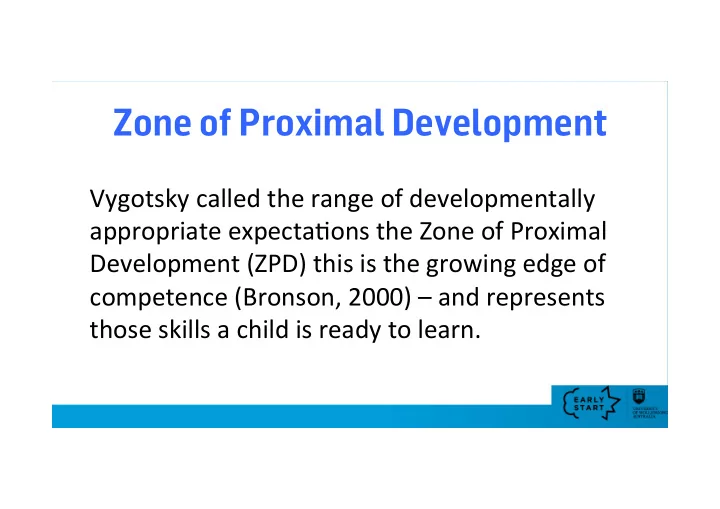

Zone of Proximal Development Vygotsky called the range of developmentally appropriate expecta7ons the Zone of Proximal Development (ZPD) this is the growing edge of competence (Bronson, 2000) – and represents those skills a child is ready to learn.
Moving through the Preschool Years … • Become much more capable of managing their emo7ons and self-control • They develop a beHer understanding of rules • They can use language to regulate behaviours • They begin to understand no7ons of reciprocity • Are more empathic • And internalise standards of behaviour
Social-Emotional Self-Regulation Sense of Self Emo+onal Skills • becoming beHer at making independent • wait and show pa7ence for things they decisions want • enjoy solving problems • manage a range of feelings such as anxiety, • feel proud of their accomplishments sadness and frustra7on • developing beHer self-control with • become more tuned in to the feelings of increased ability to manage changing others moods • use language to express how they are • building their self-esteem and confidence feeling and to acknowledge the feelings of through their rela7onships with other others children. • make self-judgments and feel pride and • Transi7on from “me” (toddlerhood) to shame. “us” (preschool
Early Years Learning Framework Suppor7ng children’s developing sense of self links nicely with the underlying Principles that support the Learning Outcomes in the EYLF. The Principles of secure, respecUul and reciprocal rela7onships assist children to feel safe, secure and supported.
Cognitive Self-Regulation Working Memory Inhibitory Control Cogni+ve Flexiblity Can hold in their mind two Can delay gra7fica7on (i.e., Succeeds at shiYing ac7ons rules and acts on the basis ea7ng a treat), also can according to changing rules of rules. Comprehends that begin to hold an arbitrary (e.g., takes off shoes at appearance does not rule in mind and follow it home – leaves them on at always equal reality to produce a response that preschool – wears differs from their natural gumboots in the rain) ins7nct (sort coloured cards by shape rather than colour)
A=en+on Babies (0-20 months) Ini+ally child’s a=en+on flits from one object, person or event to another and the baby is easily distracted. • Gradually the child begins to focus on one aspect of the environment (single channelled a=en+on), but cannot • tolerate any interrup+ons. Toddlers (16 – 36 months) Ini+ally the toddler shows single channelled a=en+on. They can concentrate on an ac+vity of their own choosing but • cannot tolerate any verbal or non-verbal interrup+ons. Gradually with an adult’s help the child can move between ac+vi+es e.g. playing a game when the adult touches • them lightly on the arm so that they look at them and listen, once the message has been heard the adult suggests they return to their game. They can alternate a=en+on with support. Young children (30 - 60 months) Ini+ally young children s+ll show single channelled a=en+on but are able to alternate a=en+on spontaneously • without an adult suppor+ng focus. Gradually a=en+on becomes two channelled so that a young child can be playing and also hear and a=end to • instruc+ons. Their a=en+on span might be short but group instruc+on is possible. The final stage of a=en+on (which may not be achieved by the age of five years) is when a=en+on becomes mul+- • channelled, well established and maintained. Auditory, visual and manipulatory channels of a=en+on are integrated. Gradually the young child is able to shut out unwanted irrelevant informa+on and concentrate on essen+al aspects of the environment.
Recommend
More recommend